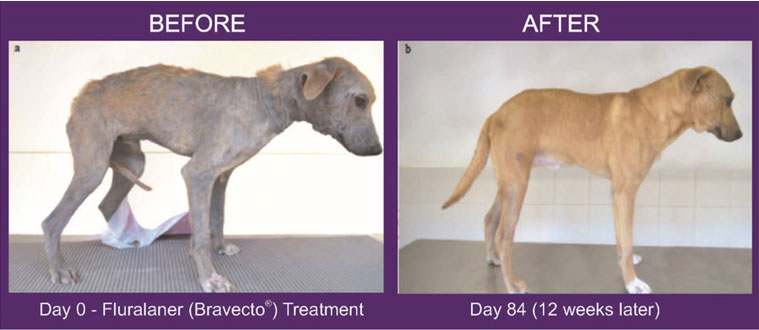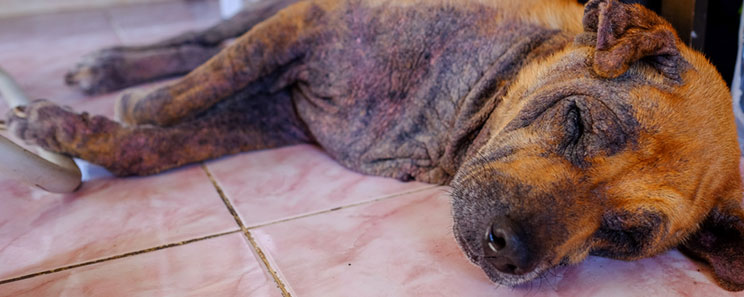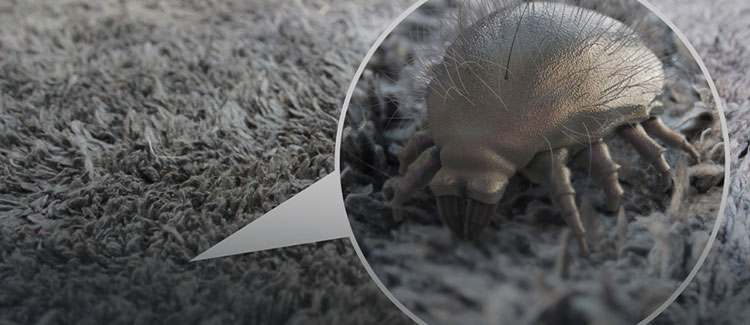Managing Mange And Mites In Your Dog
SILENT KILLERS

Posted by bravectosouthafrica – 11 June 2018
Just the sound of the word “mange” leaves an unpleasant sound in your ears. There are two different types of mange that your dog can get. Colloquially these are either called Demodex (Demodectic mange) and the more severe, Scabies (Sarcoptic mange). These types of mange in dogs are caused by parasites called, mites, living off of the expense of your little pup.

Download our
Bravecto® brochure.
What is Demodectic Mange in Puppies?
Demodectic Mange is commonly referred to as “puppy mange” as it is most commonly found in dogs younger than two years old. Demodex is an infestation of your puppy’s skin. Eight-legged mites which resemble a cigar shape, feed off the hair follicles and oil gland in your puppy’s skin.
Usually, this type of mange shows close to no symptoms in your dog. However, if your puppy has a weakened immune system or experiences immune irregularities, Puppy Mange may trigger hair loss or other dermatologic problems. In order for your puppy to strengthen his immune system and be able to face the big new world head-on, it’s important that you not only vaccinate against the common diseases, deworm, feed a good puppy food and socialise your puppy too.
As much as there are creepy-crawlies around most corners, you should raise a dog who is confident wherever he goes.

10 Tips to Socialise
your Puppy
Say it isn’t so!
How do you know your pup has mites?
Although these mites cannot be inherited and are not present on the foetus while the foetus is developing from an embryo in the uterus, the mother of your pup has Demodex mites in her skin as part of the normal skin flora and they will move onto the puppies’ skin immediately after birth.
It’s important to realise that these mites will always be present to some degree on your pup as they are a normal part of the skin flora in healthy pups if they have the right kind of immunity factors to keep them suppressed. This refers to the fact that it either affects a specific area, or it is found all over your puppy’s body.
Luckily, Demodectic mange is mostly a once-off problem, which means that most dogs won’t suffer from an uncontrolled Demodex infection once they have recovered. This is similar to how humans build up immunity against chickenpox once they’ve had it, dogs work up a defense immunity to Demodectic mange.
Can this issue get out of control?
Unfortunately, because of genetic programming, some dogs don’t produce those specific immune factors that tackle these mites. When this is the case, the chances are higher that your dog can experience a more severe and unresponsive case of Demodectic mange.
What are some of the symptoms of Demodectic mange?
- Hair loss over small patches of skin.
- Hair loss of larger areas of your pup’s body may be a symptom of a more severe form of mange.
- The skin in the areas of hair loss is mostly not red or itchy and appears normal. (in some severe cases,
- affected areas may be thickened, red and irritated as a result of secondary infections with bacteria and/or fungi)
What are the Risk Factors of Demodectic mange?
- Generally, dogs under two years of age primarily due to their immature or developing immune system.
- Purebred dogs are more likely to show symptoms than mixed breed dogs.
- Dogs suffering from an underlying disease like Canine Cushings Syndrome or any other immunosuppressive disease.
How do you treat Demodectic Mange?
More aggressive treatment will be required if it is generalised hair loss. When it isn’t too out of control, the symptoms are merely monitored and allowed to resolve on their own as the puppy’s immunity matures. At other times, a topical medication is applied to the affected area to speed up the healing process.
In more severe cases of Demodectic mange, your vet may require the use of anti-parasitic medications such as Bravecto®. Demodectic mange treatment has recently become really easy with Bravecto®, which is now registered for the treatment of mange. A single chew will help clear up your pup’s mange problem and it can be used in pups from as young as 8 weeks old. As every dog is different, your vet will ultimately prescribe the medication they feel is best suited for your specific dog. Vets can prescribe anything from anti-mite cream, anti-inflammatory creams or Corticosteroid cream.
For the larger areas, your vet could recommend using benzoyl peroxide. In cases where bacterial infections have occurred from the Demodex – antibiotics may be needed to rid your dog completely.
Helping your pup recover from Demodectic mange
With a high-quality diet and enough physical activity, the recovery of mange symptoms will be sped up. Be sure to speak to your veterinarian regarding your dog’s specific prognosis.
Here is an example of amazing results after one Bravecto® chew in a dog with generalized demodectic mange.

What is Sarcoptic Mange?
More commonly known as Scabies; this is a more severe type of mange, caused by the Sarcoptic Mite. These guys are notorious for causing the itchiest type of mange.
The Sarcoptic Mite is also known as the itch mite, a burrowing and carnivorous type of mite. Once they land on your puppy, they start burrowing into your puppy’s skin. They are microscopic and don’t need much encouragement at all, as they tunnel deeper and deeper into their new home.

How are these mites transmitted?
Unfortunately, it’s a simple case of being in the wrong place at the wrong time. It might be helpful to track back to where you were when your dog first picked up this mite, so you can avoid going there again. These creepy crawlies can be transmitted in two ways: directly and indirectly. Most cases are direct, which means that your dog came in direct contact with another infected host, allowing the mite to play tag-team or musical chairs with unsuspecting dogs.
When this type of mite gets transmitted indirectly, it means there was no host present. As if they haven’t got enough stealth already, they can also survive up to 5 days without a host. So, this means that your dog picked up one of these mites in an area where they were present and casually waiting for their next four-pawed home to stroll past. These mites can detect a new host or food source (such as our dogs and us) through heat and odour which spurs them into action.
What are the symptoms of sarcoptic mange in Dogs?
After your dog has been exposed to mites, symptoms will start appearing in about 10 days. These symptoms can include the following:
- Visible bite marks on the skin
- Severe itching (may intensify in warm conditions)
- Hair loss
- Red and inflamed skin.
- If untreated, the skin may darken due to irritation, and surrounding lymph nodes may enlarge.
Sarcoptic mange can spread over the entire body, but they prefer areas without hair (your dog’s elbows, ears, armpits, belly and chest).
There are also more subtle signs of Sarcoptic Mange like lethargy (sleep deprivation due to scratching at night), loss of appetite, weight loss, agitated and restless behaviour. The scratching due to the irritated and itchy skin is what causes the majority of your dog’s hair to fall out. Although it is treatable, in severe cases (and because it is highly contagious), it is advised that your dog is kept isolated whilst being treated.
As soon as you see your dog display any of these symptoms, be sure to contact your vet immediately.
How do you treat Scabies?
Generally, Sarcoptic Mange will be treated with a Scabicide (a drug that kills the itch mite). In less severe cases a Scabicidal dip is used to wash your dog and kill the mites living in your dog’s skin, for example Ectodex. Treatment should always be done by a veterinarian. Depending on your dog’s condition, he may need to be dipped on a weekly basis for as long as six weeks. Some treatments work, some do not as some mites have built up a resistance to the treatment.
It’s important to note that treatment for Sarcoptic Mange is ongoing and not a once off thing. This is because most treatments only kill the living mites but don’t affect the eggs. As the eggs take a while to hatch, several treatments are necessary. The good news is that Bravecto® is now also registered for the treatment of Sarcoptic mange with just a single dose with the added bonus that your dog will also be protected against ticks and fleas for 12 weeks. A follow up dose of Bravecto® should be given, not only to ensure continuous protection from ticks and fleas, but also to prevent re-infection of scabies from eggs that may be in the environment.
With the outside world proving to bring its own set of challenges and health risks, you can still make sure that the insides are covered. Your home is one of the first places your dog will get to know and get comfortable in. Make sure it’s an environment that is safe and healthy for your puppy.

Puppy Proofing
your Home
Managing Ear Mites in Your Puppy:
These rascals live in your puppy’s ear canal. They bite and itch and crawl, making it extremely uncomfortable for your dog. These ear mites cause inflammation and can lead to otitis and ear infections. Ear mites are highly contagious and frequently pass from parent to new-born. Ear mites can also pass between different species but do not affect humans.
What’s the deal with Ear Mites?
Ear Mites live on the ear wax and oil in your dog’s ear canal. They are small mites but can be spotted if you take a close look, resembling fast-moving white spots. Ear mites can affect both the internal and external canal and lead to serious skin infections. They travel easily between pets, especially if you have a household filled with cats and dogs. If your pup has an immune hypersensitivity reaction, it can result in a specifically intense irritation of the external ear canal. Although they sound quite hectic, luckily, they don’t dig too deep into your dog’s ear canal and are easier to treat than most parasitic infections. Immediate treatment, however, is crucial.
How are Ear Mites transmitted?
Ear Mites are transmitted from pet to pet through either physical contact between pets, pets shaking their heads (Mites are flung onto nearby animals) or Ear Mites moving from loose animal hair to the ground and then can be picked up by other animals.
Ear Mites are most commonly found in cats, but because they are highly contagious, they quickly move from cat to dog and vice versa.
What are the symptoms of Ear Mites in Dogs?
If your dog is infected by ear mites, the mites usually produce a dark discharge. So, start by looking for dark coffee-like debris in your dog’s ear canal.
Dogs who have been infected by Ear Mites will have the following symptoms:
- Excessive scratching at their ears while shaking their heads.
- Pulling out their hair as they scratch.
- Black/Coffee like waxy debris in ear canal.
- Inflammation
The Dangers of Ear Mites
The discomfort caused by ear mites isn’t the only problem you should be worried about. The repeated and consistent scratching causes cuts and wounds around the ear that can easily become infected. In severe cases, these infections can cause the ear canal to be blocked as well as cause a hearing imbalance.
Can you prevent Ear Mites?
If you’d like to try and prevent ear mites, it will help to frequently clean the bedding, kennel and your house in order to reduce the risk of mite infections in your home. Be sure to not miss any stray animal hairs when cleaning, as ear mites are known for transferring through loose hairs. Lastly, organise monthly check-ups and ear cleaning with your veterinarian.

Protecting Your Puppy:
Vaccination Schedule
Is there any treatment for Ear Mites?
It is important that you take your dog to the vet, so he can properly examine and diagnose your dog. If you have more than one pet, make sure that you have all of them checked for ear mites even though only one may be showing obvious symptoms. Mite infestations can easily spread, and you want to make sure you’ve got a handle on it as soon as possible.
Your vet will most likely thoroughly clean your pet’s ear canal and then continue to prescribe a suitable parasiticide. Depending on how severe the mite infection is, your vet may also prescribe antibiotic treatment. Ask your vet about Bravecto® which is now also registered for the treatment of ear mites.
Be sure to ask your vet about when and how to continue your pet’s treatment until it’s certain that the mite infestation is cleared. Remember, good pet health starts with vaccination and keeping them free from parasites. With Bravecto® now extending protection beyond just ticks and fleas but mites too with just one tasty chew which lasts for 12 weeks, protection is truly worry-free.

For more information on mites
visit http://www.bravecto.co.za
Sources:
What’s So Risky About Puppy Shots?
Demodectic Mange in Dogs
First-Year Puppy Vaccinations: A Complete Guide
Vaccinating your puppy and kitten
When can I take my puppy outside?
Discharge From a Dog’s Ear: Causes and Treatments
Ask a Vet: What Causes Puppy Mange and How Can It Be Treated?
Different Types of Puppy Parasites
Bringing a New Puppy Home? Don’t Make These 3 Mistakes.
Top dog diseases to be very aware of
How to Get Rid of Ear Mites in Dogs
Demodex in Dogs
Why vaccinate?
Demodex (Puppy Mange) in Dogs
Demodectic Mange in Dogs
Sarcoptic Mange
Sarcoptic Mange in Dogs
Dog Vaccinations
Ear mites: all you need to know
Subscribe to our Newsletter
Get to know your furry friend better! Sign up for all things dog- or cat-related.
The Hairy Facts about the dreaded hairball
12 April 2021
Help! My dog’s barking mad! Volume 2
12 April 2021
Your Itchy, Scratchy Cat – All About Cat Skin Problems
12 April 2021
The Dog’s Diet: A Bone of contention?
01 April 2021
Mango Fly Worms: How to Spot and Eliminate them
Posted on November 28,2019
Managing Mange And Mites In Your Dog
Posted on June 11,2018
Why Do Cats Purr and How? Learn What Your Cat Is Saying
Posted on October 14,2020
How to Get Rid of Ear Mites in Dogs
Posted on November 06,2019









